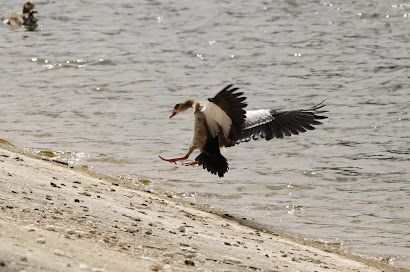With August almost over, it was time to reflect on two trips to a local birding location, the mighty Pipps Ford. An area that contains an active and disactive quarry, as well as small lakes, grassland and woodland habitats that provide a good jumble of birds to see there. This is a site I visit a lot, one I know well, I have written a lot of previous blogs so feel free to peruse those as well.
One of the cows by Riverside Farm Pit
With birding in August the main focus is on migrating WADERS as they migrate from their breeding grounds to their wintering ones. This is the Autumn migration and Pipps Ford is usually good for enticing that family of birds to stop and feed along their migration routes. They feed on the mud around the Active Quarry, and less on the finished part. When I visited the Active Quarry in July there was a lot of mud, and promised good potential coming into this month. However realignment by bulldozers meant that the glorious wet mud on the Active Quarry has been destroyed, and disturbance from those machines have scared the rest away.So the only WADERS present were a COMMON SANDPIPER on the 11/8 on the Active Quarry and 10 LAPWING on the finished part. Fairly slim pickings really, and a bit of a disappointment.
There was a pair of LITTLE GREBES on the disused quarry with young, whilst a juv GREAT CRESTED GREBE was a wanderer from the local pits.
The Active Quarry
For some reason the finished part of the quarry is attractive to ROE DEER, and that was the case on 11/8 when a pair of them were again present, the male with his short, sharp antlers. Despite my efforts I disturbed them and they galloped off through a distant hedge. This species seems to be growing in number in the area having seen them at other local sites, but its yet to be seen whether this is a good thing or not.Work on the Active Quarry
Most of the smaller quarries were fairly quiet. A flock of 16 GADWALL on Pippins Lake, was about all. In the surrounding trees there was a fledged GREAT SPOTTED WOODPECKER, whilst a flock of GOLDFINCHES numbered more than 40 birds, the thistles on the heathy grassland supports lots of seed for them, and there was a flock of 20 LINNET on the finished quarry area. There was a KINGFISHER that flew across the Active Quarry, calling away, a brief shot of sapphire.So a relatively uneventful time at one of my local sites. Well done if you've read this far, you show dedication. Sometimes you score, other times you don't. When there's no birds about it can make me feel a bit despondent, a bit empty, like I'm all alone in the world. Hopefully things will buck up and more birds shall be enticed to visit. As it is I will always be writing blogs about them.




































